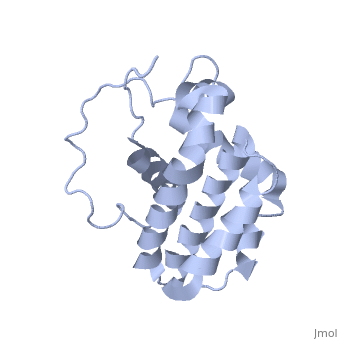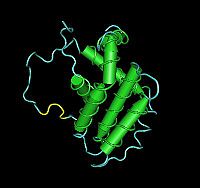B-cell lymphoma protein
From Proteopedia
| Line 1: | Line 1: | ||
{{STRUCTURE_1g5m | PDB=1g5m | SCENE= }} | {{STRUCTURE_1g5m | PDB=1g5m | SCENE= }} | ||
[[Image:Bcl-2_3D.jpg|left|200px]] | [[Image:Bcl-2_3D.jpg|left|200px]] | ||
| + | |||
| + | |||
| + | |||
| + | |||
| + | |||
==Overview== | ==Overview== | ||
Revision as of 00:58, 29 October 2009
Overview
Bcl-2 is a family of genes and proteins that govern the mitochondrial membrane permeabilization (MMP). Bcl-2 derives its name from B-cell lymphoma 2 which came from being the second member of a range of proteins initially described as a reciprocal gene translocation in chromosomes 14 and 18 in follicular lymphomas. The genes and proteins can be either pro-apoptotic (Bax, BAD, Bak and Bok) or anti-apoptotic (Bcl-2, Bcl-xL, and Bcl-w).
Apoptosis is the programmed death of cells. It is central to the development and homeostasis of multicellular organisms, and it is the route by which unwanted or harmful cells are eliminated from the organism. The mitochondria is a large contributor in the subcellular partitioning of the apoptotic activator molecules such as cytochrome c. There are several triggering agents such as Ca2+, reactive oxygen species, certain lipid molecules and certain protein kinases that can induce MMP. The interaction opens the protein permeable pores that allow the release of several proteins including cytochrome c, Smac/Diablo, AIF, Endonuclease G, etc. Depending on their activated function, Bcl-2 either promotes the release or sequesters the function of the specific proteins.
Role in disease
Targeted Therapies
Proteopedia Page Contributors and Editors (what is this?)
Michal Harel, Colin Ridenour, David Canner, Alexander Berchansky, Jaime Prilusky




